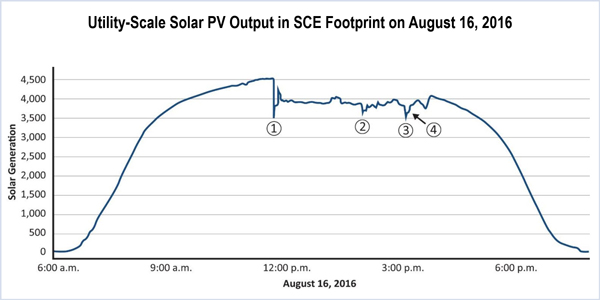By Jason Fordney
CAISO will temporarily increase its daily procurement of operating reserves in response to findings that the erroneous tripping of solar generation caused the loss of 1,200 MW of output as the Blue Cut fire burned in Southern California last August.
Beginning June 14, the ISO will procure more operating reserves in response to last week’s NERC report showing that solar inverters — which convert photovoltaic DC output to utility frequency AC — are susceptible to erroneous tripping during transients caused by faults on the power system. The ISO did not say how long it will keep the measure in place.
A NERC/Western Electricity Coordinating Council task force said the loss of inverter power injection was caused by a perceived low-frequency condition and low-voltage blocking of inverters. The inverter manufacturer recommended changes to inverter settings to prevent the erroneous tripping, and CAISO and Southern California Edison are working to develop a corrective plan.
The inverters tripped on Aug. 16 as the Blue Cut fire raged in the Cajon Pass and quickly moved toward an electric transmission corridor containing lines owned by SCE and the Los Angeles Department of Water and Power. There were 13 faults on 500-kV lines and two 287-kV faults that took down 1,200 MW of solar. The facilities did not de-energize, but they ceased output because of the system faults, with the most significant losses occurring around 11:45 am. Four of the faults (see chart) caused losses of PV generation.
CAISO said it will increase its reserves “to minimize the potential impact due to loss of inverter power injection during a single transmission contingency event.” More reserves will be procured during solar operating hours, and the total target reserve amount will be up to 25% of forecast solar production.
The task force recommended a minimum delay for frequency tripping to ensure an accurate system frequency measurement and that inverters be equipped to quickly return to operation if they cease supplying power during voltage excursions.
It also said generation owners and operators should receive an alert to ensure they are aware of recommended changes to inverter settings.
“With the proliferation of solar development in all interconnections across North America, the results of this disturbance analysis need to be widely communicated to the industry highlighting the present potential for widespread solar resource loss during transmission faults on the [bulk power system],” NERC said.
The growing use of inverter-based technologies that operate in microseconds is rapidly changing the characteristics of the power grid and presents some new challenges, NERC Vice President of Reliability Risk Management James Merlo said in a statement. The loss of generation was a “previously unknown risk to reliability,” and NERC is taking steps to mitigate the risk, he said.




